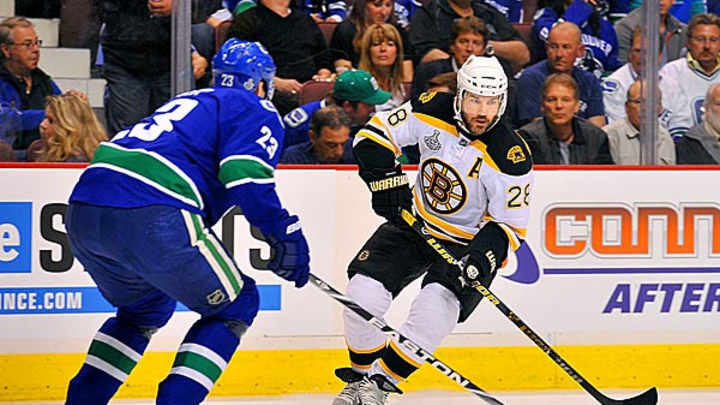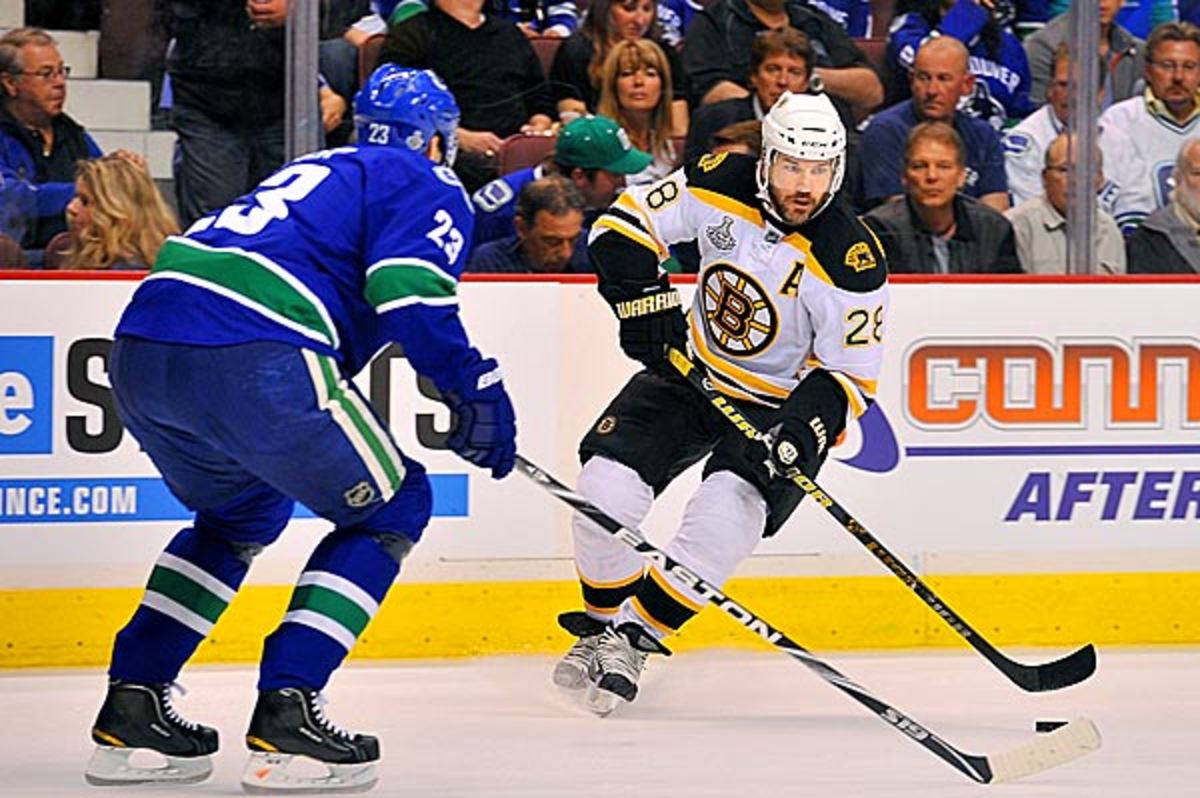What to watch for in Cup final Game 2

Mark Recchi has been a major part of the Bruins' power play struggles. (Brian Babineau/Getty Images)

By Stu Hackel
Like Akira Kurosawa's film Rashomon, in which four people describe a crime in four very different ways, Game 1 of the Canucks-Bruins Stanley Cup Final evoked very different reactions. Some found it boring, lacking flow and intensity and overmanaged by the referees who called too many penalties. Others found it a rousing opener that provided one late game-winning goal, a number of big hits, spectacular saves, a few angry scrums and something for the world to nibble on as we head for Game 2.
Bruins coach Claude Julien had his own little Rashomon going on. He called Alex Burrows' alleged bite on Patrice Bergeron's finger "a classless move." But upon hearing that the NHL's Mike Murphy somehow found "no conclusive evidence" that Burrows had been snacking on Bergeron's digit, Julien was publicly, at least, less aggrieved, saying, "Let's move on here. We're not the type of team that whines and cries about things like that."
But that didn't mean the two teams had no gripes to air. Canucks coach Alain Vigneault engaged in some verbal bumping with Tim Thomas -- or more specifically, the Bruin goalie's aggressive style that Vigneault says allows him to initiate contact with opposing forwards, who might otherwise be called for interference if they bump him. In fact, Burrows was called for tripping Thomas in Game 1 and Vigneault said he wanted clarification from the NHL. Vigneault returned to that theme Thursday, saying, "Ninety percent of his saves are where he's outside the blue paint. A lot of times he does initiate contact. That's the way he plays...We said last night that we were going to look to get a little bit of clarification on certain situations. We're sure it was going to be fine. We're going to do that here in the next couple of days."
Which means that Canucks GM Mike Gillis will be speaking with Murphy about how the refs call this.
Julien responded to his old pal Vigneault's statements on Thursday: "The rule is pretty clear. You're entitled to your ice. If he steps out and he's got that ice, he's entitled to it. That's what he's done through the whole process. Now, we all know that goaltenders are to be protected. If you're going to say he's out of his crease, he's fair game...I don't think people are entitled to run over those guys."
This matter is going to come down to who the referee decides has initiated the contact outside the crease (and if you want to familiarize yourself with Rule 69, here's the link; it may emerge as a big issue going forward. Former NHL ref Kerry Fraser provides more insight on his TSN.ca blog).
Game 1 did bog down with penalties in the second period, but in the third, when the players stuck to playing hockey, the Canucks were clearly the better club, although it took them almost the entire 20 minutes to finally score on Thomas, who made a series of terrific stops. He also began the game by making some great saves, and kept his team alive. The Canucks were the better club 5-on-5 and this has to concern the B's considering that full strength play is the area in which they have to be superior as long as their power play is shooting blanks.
Here are some other things to look for in Game 2, starting with the B's power play:
1. Yes, the Bruins had some very good moments moving the puck around and taking 12 shots on the PP in Game 1. The Zdeno Chara experiment in front of the net won praise from Julien. But Boston had a chance to take an early lead and put the Canucks on their heels and didn't. The Bruins had over eight minutes of power play time, including 1:35 of 5-on-3, and didn't score. As we noted before, Chara being in front takes Boston's best weapon, his big shot, out of the equation. And as a number of analysts have noted, he doesn't have the good hands to deflect pucks in front. While his huge frame did cause Roberto Luongo some anxious moments when Chara first camped out in front of his crease, Luongo said post-game that the Canucks adjusted by not playing him tightly and by letting him have that space. Vancouver's defensemen moved in front of Chara, and by "fronting" him, they allowed Luongo to track the puck higher in the zone. So Chara's effectiveness there can be called into question. The Canucks don't fear point shots by Tomas Kaberle and Dennis Seidenberg. Will Julien put Chara back on the point? Would Milan Lucic be better in front of the net with Chara blasting away?
Another part of the B's power play that has to be questioned is Mark Recchi's presence. His production has plummeted and he had a few good chances that he botched in Game 1. Julien has Rich Peverley or rookie Tyler Seguin at his disposal for power play duty, but the coach is often reluctant to make a change when it involves a respected veteran like Recchi.
2. The Canucks' defense will very likely be without Dan Hamhuis, who was injured delivering this hip check to Lucic.
A very nice check, but Lucic is a big body and his weight seems to have damaged Hamhuis's back, knee or ankle. He didn't practice on Friday and that removes half of the Canucks' top shutdown pair of Hamhuis and Kevin Bieksa. The Canucks do have excellent depth on the blueline, and the player most expected to enter the lineup is Keith Ballard, a teammate of three current Bruins in Florida: Nathan Horton, Gregory Campbell and Seidenberg. But the guy who joined the projected defense corps in practice was former Bruin Andrew Alberts, who is more physical than Ballard, though not as fast a skater, and perhaps better in Vigneault's estimation to play a defensively-oriented game. Vigneault noted on Thursday he already has two players in Christian Ehrhoff and Alex Edler who move the puck the way Ballard does. The pairings were adjusted so that Aaron Rome, excellent defensively in Game 1, moved into Hamhius's spot (although he's played the right side and Hamhuis has been on the left), Alberts joined Ehrhoff and Edler remained with Sami Salo.
3. The Bruins didn't get a lot of traffic and pucks to the net at full strength. Neither Lucic nor Horton played particularly well on the top line centered by Krejci, and if that trio isn't going, it diminishes Boston's chances greatly. Lucic wasn't strong with or without the puck, he made a few bad passes, couldn't get the puck deep on the play that led up to the winning goal, and generally seemed behind the pace of the game. Horton took five shots, but none from dangerous areas. The whole team will have to raise its battle level for Game 2, but it starts up front. Led by Bergeron, the Bruins did well in the faceoff circle, winning 56 percent of the draws, but that didn't translate to any sustained offense. The Canucks didn't allow many second chance opportunities and Luongo smothered a number of shots and didn't allow Boston to get into an offensive rhythm.
4 The Sedins had an up and down game, buzzing in Boston's end at times, but sometimes forcing the play and being stymied by Chara. Vigneault got the twins on the ice a few times when Chara was on the bench, but Boston was able to change out of the bad match. That bears watching in Game 2.
5. If Ryan Kesler was injured, he sure didn't show it. Not only did he make a marvelous play to set up the game winner...
... he was a force all game, and when he turned it up -- circling in his own end and tapping his stick on the ice to call for an outlet pass, then steaming forward -- he was hard to stop, like on this play:
The Canucks' second line center, Kesler made that play with third-line wingers Jannik Hansen and Raffi Torres, whose regular line with Maxim Lapierre was once again hard to contain as it has been for much of the playoffs. Lapierre has a number of enemies on the Bruins from his years in Montreal, and his running battles with them (especially Andrew Ference and Chara) have resumed. Hansen, who made a sweet pass to Torres on the winner, doesn't have the high profile of his linemates, but his hockey IQ and puckhandling complement them very well. By contrast, Julien changed his third line, replacing Seguin with Rich Peverley alongside Michael Ryder and Chris Kelly during the game, so Boston has to figure out how to get its third trio going.
6. The Bruins, especially their defense corps, sagged in the third period as the Canucks regularly went through them and drove to the net. Boston doesn't often fade in physical games, but the Canucks are at least the Bruins' equal in that department. It's worth keeping an eye on how the Canucks play Chara, and the pounding they administer in an effort to wear him down. His play in front of the net on the PP increases the pounding. Of course, they same goes the other way, which is why the first two periods were as nasty as they were. But Chara seems to be singled out for rough treatment, as evidenced by Vancouver high-sticking him twice during the game. It will take a lot to drain him, and when Torres, who usually creams his victims, ran Chara in the first period, he bounced off the big Bruin and fell to the ice. By the end of the game, however, Boston's captain didn't seem so fresh.
7.Johnny Boychuk, who gambled and lost on the game-winner by trying to intercept Bieksa's pass to Kesler, has been on the ice for the last seven goals against Boston. Julien was asked about that on Thursday and would not criticize Boychuk publicly, staying on message with his eyes looking ahead, not behind. "I think if you ask him, he knows he probably could have played that last goal a lot better," Julien admitted. "We all know that, but we all need to move on right now."
